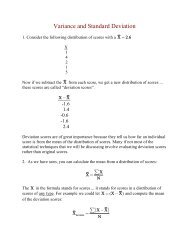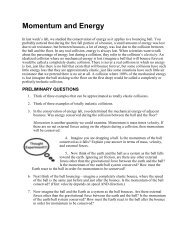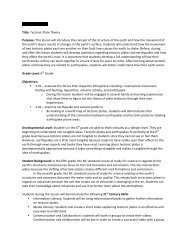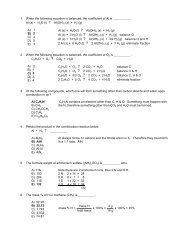AST 1001 Introductory Astronomy I Study Guide for Exam #2 This ...
AST 1001 Introductory Astronomy I Study Guide for Exam #2 This ...
AST 1001 Introductory Astronomy I Study Guide for Exam #2 This ...
You also want an ePaper? Increase the reach of your titles
YUMPU automatically turns print PDFs into web optimized ePapers that Google loves.
<strong>AST</strong> <strong>1001</strong><br />
<strong>Introductory</strong> <strong>Astronomy</strong> I<br />
<strong>Study</strong> <strong>Guide</strong> <strong>for</strong> <strong>Exam</strong> <strong>#2</strong><br />
<strong>This</strong> exam will consist of 50 to 100 multiple-choice questions. Questions will be drawn mainly<br />
from lecture notes, with some questions coming from lab exercises and handouts, homework<br />
exercises, and from Chapters 6, 7, and parts of 5 (orbits, tides) of the book. Most equations and<br />
constants will be provided. Bring pencils and an eraser!<br />
=====================================================================<br />
ORBITS AND TIDES<br />
(0) We covered a few items regarding orbits and tides, from Chapter 5, right after the first<br />
exam. Be sure to review your notes and know such concepts as low-earth orbit,<br />
synchronous orbit, conic sections, escape velocity, differential gravitational <strong>for</strong>ces, spring<br />
tides, neap tides, earth tides, relative importance of sun and moon in those. Are births<br />
related to the Moon?<br />
LIGHT AND THE ELECTROMAGNETIC SPECTRUM<br />
(1) You should understand the electromagnetic wave model <strong>for</strong> light, that it is a transverse<br />
wave in the electric and magnetic fields. You should understand the terminology <strong>for</strong><br />
waves--frequency, wavelength, velocity, and the equation relating them.<br />
(2) Be familiar with the photon concept of light--how light interacts with matter one photon at<br />
a time and that the energy of the photon is proportional to the frequency.<br />
(3) You should know the order of the electromagnetic spectrum (gamma rays, X-rays, UV,<br />
etc.), and which are longer wavelength (or lower frequency) than which others, etc. Do<br />
not memorize any particular actual wavelengths except <strong>for</strong> the range of visible light (in<br />
Angstroms) -- you should know this!<br />
(4) You should know how light is dimmed according to the inverse square law, as discussed<br />
in the book, and be able to do a simple calculation.<br />
(5) Know what the Doppler effect is and how it changes the wavelength of light.<br />
OPTICS & THE OPTICS OF TELESCOPES<br />
(6) You should understand how light refracts when it encounters a boundary between two<br />
materials of different index of refraction (what is the definition of n?). Know which way it<br />
refracts with respect to the "normal" line when going from a region of higher n to lower n<br />
(and vice versa). You should understand the argument <strong>for</strong> this directional change as based<br />
on our diagram of wavefronts hitting the boundary at an angle. Know that dispersion<br />
occurs because n is a function of ë.<br />
(7) You should understand how rays refract through a simple positive or negative lens, and be<br />
able to sketch the ray diagrams. Know what the focal length is <strong>for</strong> a lens or mirror.
(8) You should understand the basics of the law of reflection and how reflective optics work.<br />
(9) You should know the optical causes and characteristics of familiar natural phenomena<br />
such as rainbows and the halo sometimes seen around the sun or moon.<br />
(10) You should be able to sketch the optical path of a simple refracting (lens) telescope and<br />
the several types of reflecting (mirror) telescopes we discussed in class (Newtonian,<br />
Cassegrain, prime focus, etc.). You should know what the optical problems are <strong>for</strong><br />
telescopes (aberrations, etc.), and why all very large telescopes are reflectors. Know that<br />
we build large diameter telescopes <strong>for</strong> increased light-gathering power and angular<br />
resolution, NOT <strong>for</strong> increased magnification. You should also know that the lightgathering<br />
power of a telescope is proportional to the objective lens or mirror's area, which<br />
is proportional to the diameter squared. Know how to calculate the magnification of a<br />
telescope.<br />
TELESCOPES O' THE WORLD<br />
(11) You should know something of the history of the development of telescopes--the<br />
contributions of Galileo, Newton, Jansky.<br />
(12) You should be familiar with the major optical telescopes in current use, such as those at<br />
Mt. Palomar, Kitt Peak, Cerro Tololo, Manua Kea, etc.). That is, know where the largest<br />
telescopes are (as well as why they are there), and their diameters (largest reflector and<br />
largest refractor).<br />
(13) You should understand that modern observational astronomy does not rely on visual<br />
observing but on instrumentation such as spectrographs and CCDs. Know that perhaps<br />
the most commonly used tool is the computer!<br />
(14) You should be familiar with the major radio telescopes of the world (Green Bank/NRAO,<br />
VLA, VLBI). Who started radio astronomy? Understand the reasons that radio<br />
telescopes are much larger than optical telescopes (Rayleigh's criterion and the energy of a<br />
photon), and how interferometry is used to increase the angular resolution of radio arrays.<br />
(15) Know what the major astronomical satellites are/were/will be (IUE, IRAS, Hubble Space<br />
Telescope, and Chandra), and why we use satellites to observe. Know their general<br />
properties (region of the spectrum, etc.).<br />
PHYSICAL PROCESSES<br />
(16) Know what the most common two elements are in our Universe and solar system, and<br />
how the rest comprise a small (how small?) percentage of the abundances.<br />
(17) You should understand how temperature is the measure of the speed of gases, and how<br />
that, coupled with the concept of escape velocity, explains the gasses we find on the<br />
different planets. Understand how the pressure of an atmosphere declines with increasing<br />
altitude.
(18) You should know that blackbody (thermal) radiation is given off by all objects. You<br />
should know what the intensity (brightness) vs. wavelength diagram looks like <strong>for</strong> a<br />
blackbody and how it changes as the temperature of the blackbody changes. You should<br />
understand that the total energy given off by a blackbody is proportional to T 4 (Stefan-<br />
Boltzmann Law), and be able to calculate simple changes in this energy output <strong>for</strong><br />
changes in temperature (e.g., if the two blackbodies differ in temperature by a factor of 2<br />
then their energy output differs by 2 4 = 2 x 2 x 2 x 2 = 16 ). You should understand that<br />
the peak wavelength of the radiation curve is inversely proportional to the blackbody's<br />
temperature (Wien’s Law.) Have an approximate idea of the peak wavelength of the<br />
Sun and of an incandescent light bulb. Also, be familiar with temperature scales<br />
(Fahrenheit, Celsius, Kelvin)--know what these are based on and their values <strong>for</strong> absolute<br />
zero and the freezing and boiling points of water. Know that everything is in a balance of<br />
absorption and emission of radiation–this is called thermal equilibrium.<br />
(19) Understand the model of the atom and the concepts of nuclear fusion and fission. What<br />
does Duke Power do? What do stars do? What is the half-life of an element and how is<br />
that used to date things?<br />
(20) You should understand how heat flows–by radiation, conduction, and convection.<br />
LAB: You should understand the concepts and techniques developed in lab exercises that we<br />
have done. You are responsible <strong>for</strong> all labs done, whether you were in attendance or not.<br />
HOMEWORK:<br />
Be able to do problems similar to those assigned as homework.<br />
MISC.:<br />
You should understand the causes of the moon's phases and the reason the Earth<br />
experiences seasons. You should also be able to express a mathematical<br />
computation’s result to the correct number of significant figures.


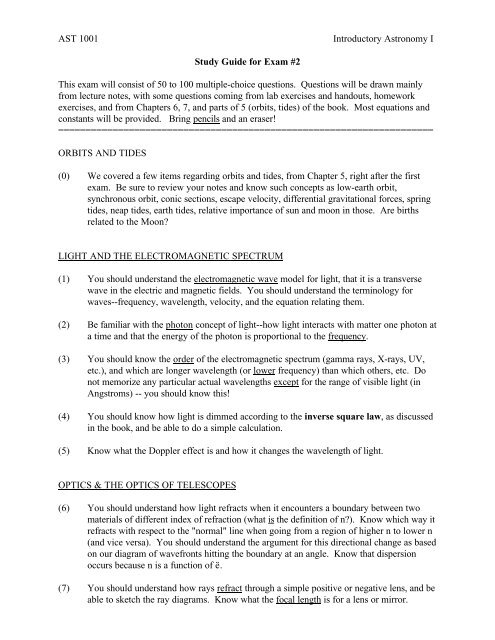


![Graduate Bulletin [PDF] - MFC home page - Appalachian State ...](https://img.yumpu.com/50706615/1/190x245/graduate-bulletin-pdf-mfc-home-page-appalachian-state-.jpg?quality=85)
